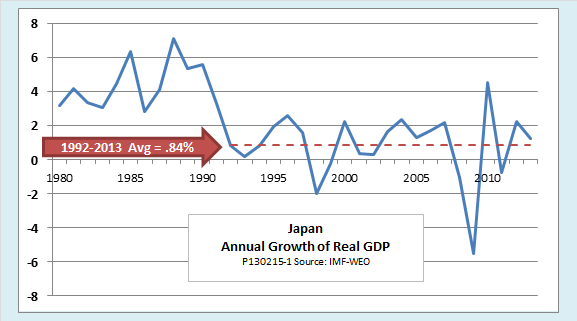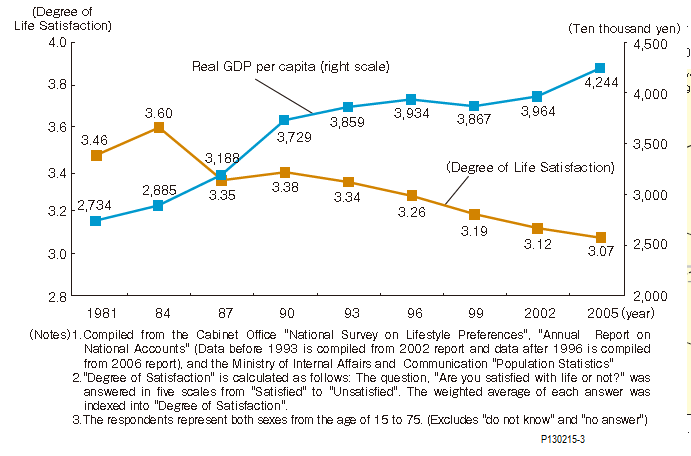There is a growing concern that economic growth, as we know it, is coming to an end. Economists, who tend to view growth as good, are uneasy with that idea. Many environmentalists, who are more prone to focus on the downside of growth, view a steady-state economy more positively. Richard Heinberg, author of the book The End of Growth, sees a no-growth economy as an immanent reality to which we must adapt whether we want to or not. In his view, whether the no-growth future works out well or not depends on how well we manage the transition. If we manage it well, we can maintain and even improve our quality of life without an ever increasing GDP. If not, he sees a much less pleasant future.
But rather than speculate about what a no-growth future might look like for the United States, why not see what we can learn from Japan, where a no-growth economy, or something close to it, has been a reality a generation already. (The Japanese population peaked in 2008, but as of 2013, it is still about 2.5 percent higher than in 1992, so per capita GDP growth has averaged even less than shown in the chart.) What does the Japanese experience suggest about the linkage between economic growth and the quality of life?
Growth vs. quality of life
To answer that question, we need to do two things. First, we need a way of measuring the quality of life. Second, we need to distinguish between the effect on quality of life of a country’s level of income and the effect of growth per se. Putting these two things together allows us to formulate the following hypothesis:
If growth of income, independently from the level of income, is a necessary condition for maintaining a high quality of life, then slow-growing Japan should have a lower quality of life than other countries with comparable incomes but more rapid growth.
IMF data rank Japan as twenty-fifth in the world by per capita GDP at purchasing power parity, just behind France and just above the EU average. That puts Japanese GDP per capita at 70 percent of the United States. Although some other rankings put Japan a little higher or lower, all sources put the country safely in the top quartile by GDP per capita, but below the top decile. On the other hand, its recent average growth rate of 0.84 percent per year puts it in the bottom growth quartile. The question is, then, do measures of Japan’s quality of life more closely track its level of GDP, its growth rate, or neither?
There have been many attempts to quantify the quality of life. Because these efforts differ widely in their methodologies, we should look more than one. Here is how Japan stacks up according to some of the better-known quality of life indexes:
- The Economist Intelligence Unit’s Quality of Life Index includes measures of material wellbeing, health, political stability, family life, community life, climate, job security, freedom, and gender equality. For 2005, Japan ranked seventeenth in quality of life out of 111 countries surveyed, compared with a rank of sixteenth for GDP per capita. It ranked well ahead of France and Germany in quality of life, and just four places behind the United States, despite being 15 places behind the U.S. in terms of income.
- A similar index from Numbeo.com ranked Japan thirteenth out of fifty-one countries for quality of life compared with a ranking of twentieth for per capita GDP. First-place rankings for low crime, safety, and quality of health care boosted Japan’s ranking on the Numbeo scale.
- The Legatum Prosperity Index for 2012 placed Japan at the eighty-fifth percentile, or twenty-second out of 142 countries surveyed. That put it one place behind France and ten behind the United States. High rankings for governance, health, safety and security, and education helped Japan’s rankings on the Legatum index.
- The UN Human Development Index, which combines scores for education, longevity, and income, places Japan at the ninety-third percentile, twelfth out of 165 countries surveyed. By comparison, the EU average on the Human Development Index ranks twenty-fifth.
- On the OECD’s better life index (all indicators ranked equally), Japan scores twenty-second out of 36 member countries. As in other indexes, it scores high for health and safety indicators. It compares poorly on work-life balance (even worse than the low-ranked United States) and below average on subjective surveys of life satisfaction. It scores poorly on the OECD’s index of gender equality (thirty-third out of 36), although curiously, Japanese women report higher subjective happiness scores than men. To put these results in context, we should keep in mind that the OECD is an exclusive club of high-income democratic countries. Among OECD countries, only Greece, Portugal, and Italy have had slower average GDP growth since 1999.
This is only a sampling of quality of life indicators, but we can see a clear pattern: By many if not all measures, the quality of life in slow-growing Japan is higher, not lower, than the quality of life in faster-growing countries at with comparable levels of per capita GDP. The Japanese example suggests that growth is not a necessary condition for a good quality of life.
How well is Japan managing its transition to low growth?
Toward the end of his book, Heinberg spells out a default scenario that he thinks will unfold as growth comes to an end in an advanced economy. His scenario includes financial collapse, militarization, civil unrest, political repression, collapse of social services, and other ills. Clearly, Japan has avoided most of those troubles, at least so far, but that does not mean it has managed the transition to low growth perfectly.
For one thing, the Japanese labor market has not fully adjusted to slow growth. As the following chart from Japan’s Statistics Bureau shows, he country’s traditionally low unemployment rate has risen, especially for young people. 
Logically, there is no reason why a slow-growing economy should have more involuntary unemployment than a growing one. Two things make the rising unemployment rate is especially problematic for Japan. One is the fact that an aging population means that there are fewer people of working age per retiree. By itself, that would suggest that jobs would be getting harder to fill and unemployment would be falling. The other odd thing about rising Japanese unemployment is the fact that a poor life-work balance is one of the few major negatives in the Japanese quality of life picture. It would seem that some adjustment is needed to move away from a situation where some people are working crazy 14 hour days while others have no jobs at all.
In addition to its labor market problems, Japan has not yet found the right combination of monetary and fiscal policy to bring its economy back to an acceptable equilibrium. Increasingly desperate efforts to reignite the growth engine are leading to developments in monetary policy, exchange rates, and public debt that many observers believe to be unsustainable. (For more on Japan’s macroeconomic and demographic problems, see Japan’s Looming Singularity by Ed Hugh, posed to Economonitor on February 12.)
Environmentalists find grounds to criticize Japan’s performance as well. They would like to see a greater use of sustainable energy and lower carbon emissions as part of the transition to a comfortable zero-growth future, but the country is not doing well in that regard. In fact, since the Fukushima nuclear disaster, it has become even more dependent on imported fossil fuels. The OECD rates Japan’s air quality below average and falling.
Finally, although many of the international rankings cited above give Japan high quality of life scores, the Japanese themselves do not always do the same. A white paper from Japan’s Cabinet Office shows a steady decline in subjective life satisfaction, as measured by the simple question “Are you satisfied with life, or not?” The same white paper reports that 60 percent of the working-age population feels stressed every day. Income, budget, work, and study are the most common sources of stress, far outweighing more personal stress factors like health, relationships, or caring for family members. There is a strong negative correlation between the amount of personal time people have and their level of stress. Logically, all of this suggests that less time spent generating GDP would improve the quality of life. 
The bottom line
When all is said and done, what do we learn from Japan’s experience with near-zero growth? It seems to me that we can see a glass that is half empty, if we want, or half full. Certainly the transition to a low-growth economy has not been ideally managed. The Japanese themselves do not appear to be pleased with their status as the world’s leading no-growth nation, and in some respects, they appear to be less pleased as time goes on. If there were a simple “start” button to get Japan’s GDP growing again, a referendum on whether to push it would undoubtedly draw a majority vote of “yes.”
On the other hand, Japan’s experience seems to tell us that the end of growth does not mean the end of everything. Even without growth, Japan seems to have a better handle on many of life’s pressing problems, including health care, longevity, public safety, and personal security than does the faster-growing and wealthier US economy.
I do not share Richard Heinberg’s alarmist view that the Great Recession marks a permanent and fundamental break from the past, so that economic growth as we know it is over and done with, starting right now. On the other hand, many mainstream economists do see U.S. growth rates slowing in coming decades. Heinberg is surely right to maintain that, as we face that prospect, we should think about how to manage the transition from “growth as we know it” to something that continues to improve the quality of life without the unwanted side effects of personal stress and environmental degradation. More on that in a future post.
Original post
